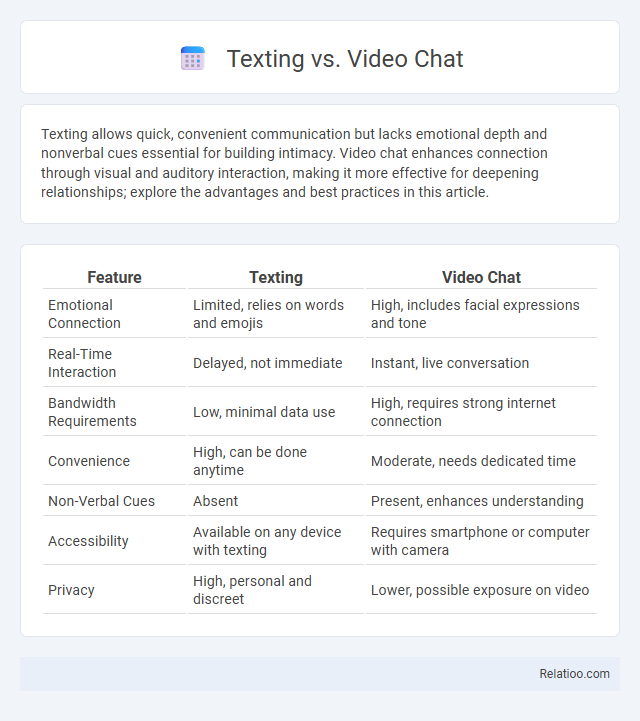Texting allows quick, convenient communication but lacks emotional depth and nonverbal cues essential for building intimacy. Video chat enhances connection through visual and auditory interaction, making it more effective for deepening relationships; explore the advantages and best practices in this article.
Table of Comparison
| Feature | Texting | Video Chat |
|---|---|---|
| Emotional Connection | Limited, relies on words and emojis | High, includes facial expressions and tone |
| Real-Time Interaction | Delayed, not immediate | Instant, live conversation |
| Bandwidth Requirements | Low, minimal data use | High, requires strong internet connection |
| Convenience | High, can be done anytime | Moderate, needs dedicated time |
| Non-Verbal Cues | Absent | Present, enhances understanding |
| Accessibility | Available on any device with texting | Requires smartphone or computer with camera |
| Privacy | High, personal and discreet | Lower, possible exposure on video |
Introduction to Texting and Video Chat
Texting enables quick, asynchronous communication through written messages, making it ideal for brief updates and multitasking. Video chat provides real-time, face-to-face interaction, enhancing emotional connection and clarity during conversations. Both mediums cater to different communication needs, with texting offering convenience and video chat supporting richer social engagement.
Evolution of Digital Communication
The evolution of digital communication has rapidly shifted from basic texting to video chat, enhancing real-time interaction and emotional connection. Video chat platforms like Zoom and FaceTime provide immersive conversations, while texting offers asynchronous convenience for quick updates and multitasking. Your choice between these modes depends on the context, urgency, and personal preference for engagement depth.
Key Differences Between Texting and Video Chat
Texting allows for asynchronous communication through written messages, enabling users to respond at their convenience without requiring real-time interaction. Video chat facilitates synchronous, face-to-face communication, providing visual and auditory cues that enhance emotional connection and reduce misunderstandings. Key differences include immediacy, with video chat requiring simultaneous presence, and sensory engagement, where video chat captures facial expressions and tone, unlike texting's reliance solely on text.
Pros and Cons of Texting
Texting offers convenience and low-pressure communication, allowing you to respond at your own pace and maintain a written record of conversations. However, it lacks the emotional nuance and immediate feedback found in video chat, which can lead to misunderstandings or slower conflict resolution. Despite these drawbacks, texting remains an efficient tool for quick updates and casual interactions, especially when visual or vocal cues are unnecessary.
Pros and Cons of Video Chat
Video chat offers real-time visual and auditory communication, enhancing personal interaction and reducing misunderstandings compared to texting. It requires stable internet connectivity and can be hindered by technical issues like lag or poor video quality. Privacy concerns and the need for a suitable environment may limit its convenience, unlike the asynchronous nature and discretion provided by texting.
Situational Use Cases for Each Method
Texting excels in quick, asynchronous communication ideal for brief updates or when you need to share information without interrupting your day. Video chat becomes essential for complex discussions, emotional connections, or collaborative tasks requiring visual cues, making it perfect for remote team meetings or personal conversations. Your choice depends on the context: use texting for convenience and efficiency, video chat for engagement and clarity, and voice calls when tone and speed matter most.
Impact on Personal Relationships
Texting enhances quick, asynchronous communication, allowing for frequent check-ins that help maintain connection, but lacks emotional nuance which can lead to misunderstandings. Video chat provides rich, real-time interaction with visual and auditory cues, strengthening emotional bonds and fostering deeper understanding in personal relationships. Relying solely on texting may weaken intimacy over time, while integrating video chats can improve empathy and relational satisfaction by combining convenience with emotional presence.
Privacy and Security Considerations
Texting offers simplicity but often lacks end-to-end encryption, making it vulnerable to interception compared to secure messaging apps that implement robust encryption protocols. Video chat platforms require stringent security measures such as encrypted data streams and secure authentication to protect against eavesdropping and unauthorized access. Evaluating privacy settings, data retention policies, and platform reputations is essential for minimizing risks in both texting and video communication methods.
Accessibility and Technology Requirements
Texting requires minimal technology, relying on basic mobile phones with SMS capabilities, making it highly accessible across various demographics and regions with limited internet connectivity. Video chat demands higher bandwidth, compatible devices with cameras, and reliable internet, which can limit accessibility in areas with poor network infrastructure or for users without advanced smartphones. Accessibility in texting benefits users with hearing impairments or those in noisy environments, while video chat provides visual cues valuable for communication but may exclude those lacking necessary technology or stable internet connections.
Choosing the Right Communication Method
Choosing the right communication method depends on context, urgency, and clarity needs. Texting offers convenience and quick information exchange for simple or asynchronous conversations, while video chat provides richer interaction with visual cues ideal for collaboration and emotional connection. Evaluating the message's complexity and the participants' preferences ensures effective communication and stronger engagement.

Infographic: Texting vs Video Chat
 relatioo.com
relatioo.com